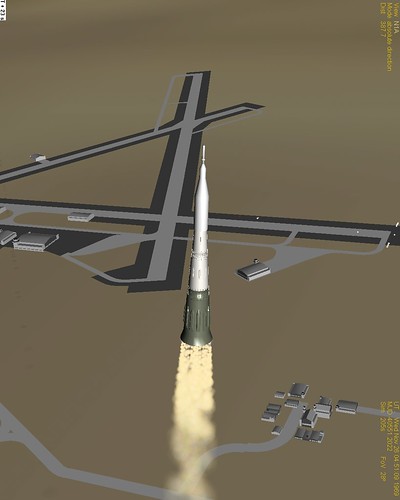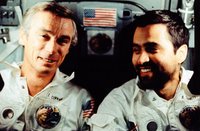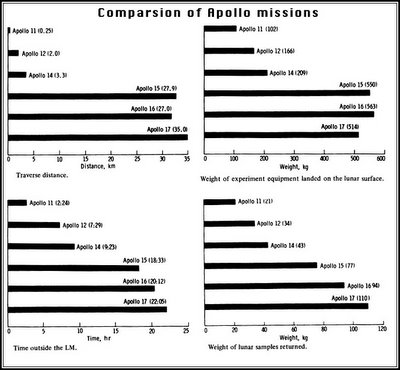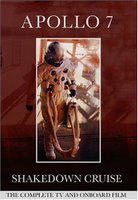
In case you haven't noticed, I'm kind of a
pessimistic person, so when I ordered on the web
Apollo 7: Shakedown Cruise, just a week before heading for Europe, it sure sounded like an outburst of optimism on my part ... Needless to said, I only received the DVD when I returned home, 2 weeks after ... Anyway, it took me some times to watch all its contents, and I'd like to share a few comments on it .... sort of a review I guess. I had to use
VLC to grab a few images from the DVD, don't base your opinion on the rather poor quality of the snapshots you'll see in this post, the DVD image quality is much better.
The set by
Spacecraft Films, is composed of two DVD (there's a
trailer online) and of a little
pamphlet which offers a short
overview of the mission and lists the contents of both discs. The set covers the
preparation,
departure and
recovery as well as the full
television broadcast and
onboard camera videos. Most (if not all) of the videos feature some kind of audio contents but, aside from the launch, they do not have their matching audio. That may sound a bit desapointing but in most case it make sense. Only über-nerds would want to listen to the audio of the
altitude chamber test ;-)
The
Preparation section use 3 separate pre-flight interviews of
Wally Shirra (CDR),
Don Eisele (CMP) and
Walt Cunningham (LMP) as audio for the videos its contains:
- Altitude chamber
- Crew briefing (with Deke)
- Inside view of the spacecraft
- Countdown Demonstration Test (CDDT)
- Interview with the crew in front of the launch complex
- Launch complex 34 views
- Suiting-up on launch day
- Crew walkout and white room views
- Crew insertion in the Command Module
- Closing of the hatch
Each of the interviews covers separate aspects of the mission, depending on the assignment of the interviewed in the crew. With the Commander (CDR), the interview mostly focus on the mission objectives (but also on the various simulators used in preparation for the mission). With the Command Module Pilot (CMP), the subjects range from its background and duties on the mission (and CMP's duties in later flight) to details of the navigation system. As for the Lunar Module Pilot (LMP), the interview, once his background and job during the flight (there was no
Lunar Module on this flight) have been covered, jumps to some details on the first days on orbit, the planned rendez-vous with the
S-IVB, the Apollo systems and deorbiting. As for the videos, they are pretty much all interesting (aside from some part of the Launch Complex one) and of
good quality:

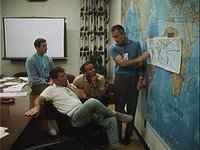
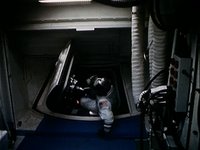
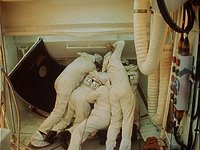
It's only by watching these videos that we can see that getting out of the CM in full suit isn't an easy task, and that closing (from the outside only?) the hatch requiere up to 5 pad crews members!
A video of the Launch Pad with the SA-205 rocket (day and night) provides the background for the pre-launch press conference (recorded a day before the launch). It's interesting to note that one of the question answered by a panelist is about what will be done with the left-over
Saturn IB. Altought the name
Skylab isn't mentioned, a reference to a planned orbital
space station is made.
The second section
Departure is composed of the following videos:
Like I was saying earlier, the launch video features the real audio track from a few seconds before the launch to
orbit insertion. Sadly, it turns into audio only after the
S-IVB ignition. The multi-angle feature is the major grip I had with this DVD. I don't know if it's because I'm too dumb to figure out how to use it, or if the DVD players (I tried in my living-room and with
WinDVD on my PC) I use don't support it well (or if it's the DVD fault) ... but man, I had a real hard time with it. I don't event know if I saw everything there is to see! I keept pressing the multi-angle button but nothing was happening then suddently the view was changing to another angle ... sometimes it changed angle on it's own ... Well it was a frustrating. I wish I had mastered that part better 'cause some of the angles were offering some pretty neat views (BTW, there is a
video of the launch available online, courtoisy of the good people at the
National Air and Space Museum).
The rest of the videos in the section, offers as audio the post-launch press conference ... but as they talk about the Spacecraft Lunar Module Adapter (SLA) panels issue (one of the panel didn't fully open) it is clear that this conference didn't occurs until at least 3 hours into the mission.
The next section regroup all the
Television broadcasts from the
Lovely Apollo room, and is mostly composed of views of the crew working/exercising/joking as well as tours of the spacecraft. It's kind of funny to hear the
Capcom telling the crew that the quality of the pictures is
"real good" ... when it's pretty hard to figure just what the heck we are looking at. See for yourself:
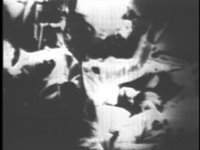


Nevertheless, all seven TV transmissions are interesting and most of the images are not all that bad:

Or maybe they are .... can you read the above message? :-) In the fourth transmission (which is missing 01:41mn of video at the beginning) the crew shows
weightlessness and one of them make a statement that I found rather funny
"... use legs a lot more than in 1G ... like a monkey in his cage" :-)
The previous to last section of this DVD set, contains all the
Onboard videos, which were taken by the crew using a 16mm
Data Acquisition Camera (DAC). The audio track is a post-flight briefing with the Apollo management. I wishs they had used real audio from the mission as it will have been a much better choice. Of course finding the correct audio for the right video sequence will have been a bit difficult, but it will have been way more interesting as given use a context to what was been recorded. As for the quality of the video ... well there is little doubt that the images looks way better than the TV transmission, and they are in colors!
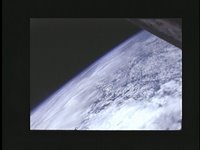

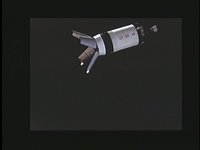


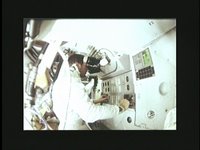
During the 35 minutes (34:50 to be precise) of this section, I counted the following 13 sequences:
- View of the sea from orbit
- Some stuff flying by with the Moon in the background
- View of the earth curvature
- View of the surface with orbital motion
- Rendez-vous with the S-IVB stage (including some close-up)
- S-IVB stage slowly tumbing away
- Orbital motion
- One member of the crew getting into his suit
- Sunrise in space
- Crew doing some stuff (eating, 0G demo)
- CMP at the G&C optics
- More crew doing stuff
- Tour of the Command Module
The last section of the DVD,
Recovery, is composed of 5 sequences and use audio from the de-orbit burn and recovery as well as the message addressed to the crew by
LB Johnson:
- Capsule in the ocean
- Crew extraction
- Crew on the deck of the USS Essex
- Return of the crew to the Cap (or is it Houston?)
- Some views of the crew in debriefing
So, is that set worth the +$30 (CAN) it cost? Well ... yeah I think so. The quality is good, the menus are simple and easy to use and the contents is interesting even if the mission isn't the most exciting of all. And so, aside from the little things I noted in this review, this a good purchase that I recommend to all interested in this particular mission.
 After having spend most of the x-mas break reading about the N1 moon rocket and trying out the already existing addon for Orbiter, I have decided to try to write my own N1-L3 addon. Initialy, my idea was to continue the good work that McDope and al. had done, but from the feedback I got on the forums, it looked like this wasn't a good idea as the author of the addon didn't want anyone taking over his project ... nevermind the fact that the project haven't been worked on for more than a year and that all the source code is included ... Anyway as I think that author's wishes should be respected, I have started working on a addon, built from scratch (using the very sparse data available on the web on the Soviet Moon Program). In fact this is much better as this allow me to learn even more things. The only problem is that I cannot do the 3D models ... so in order to get started I'll be using the one from the old addon, then , once I'm ready to release something, I'll switch to use someone else (with permission of course) meshs. Lukily, Urwumpe (one of the addon maker) has been working on some great looking one:
After having spend most of the x-mas break reading about the N1 moon rocket and trying out the already existing addon for Orbiter, I have decided to try to write my own N1-L3 addon. Initialy, my idea was to continue the good work that McDope and al. had done, but from the feedback I got on the forums, it looked like this wasn't a good idea as the author of the addon didn't want anyone taking over his project ... nevermind the fact that the project haven't been worked on for more than a year and that all the source code is included ... Anyway as I think that author's wishes should be respected, I have started working on a addon, built from scratch (using the very sparse data available on the web on the Soviet Moon Program). In fact this is much better as this allow me to learn even more things. The only problem is that I cannot do the 3D models ... so in order to get started I'll be using the one from the old addon, then , once I'm ready to release something, I'll switch to use someone else (with permission of course) meshs. Lukily, Urwumpe (one of the addon maker) has been working on some great looking one:


